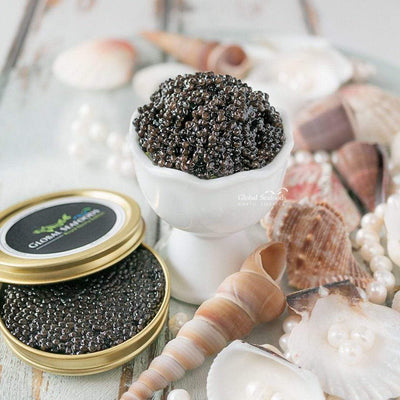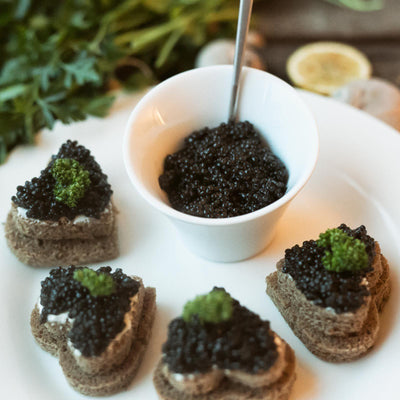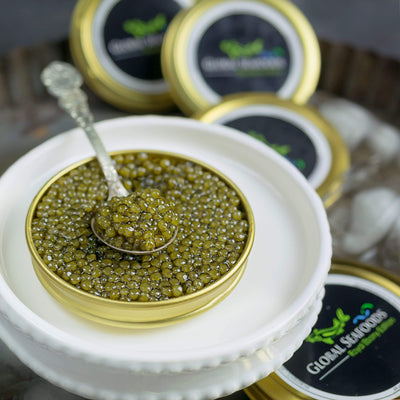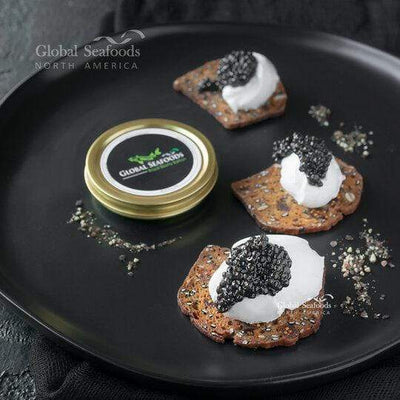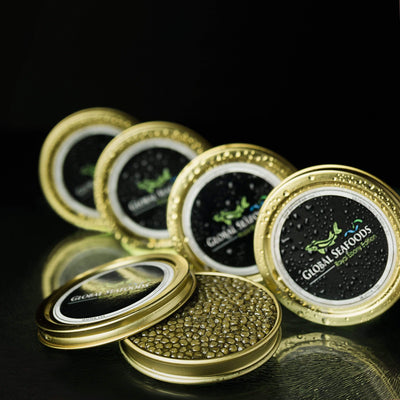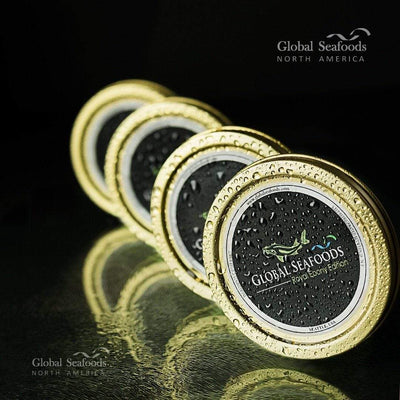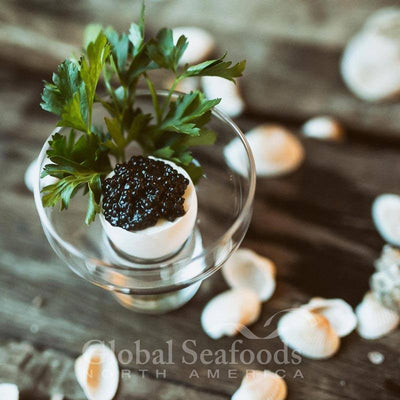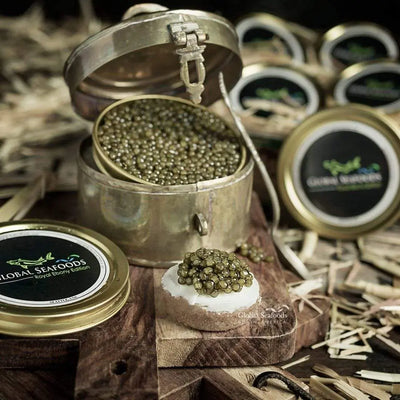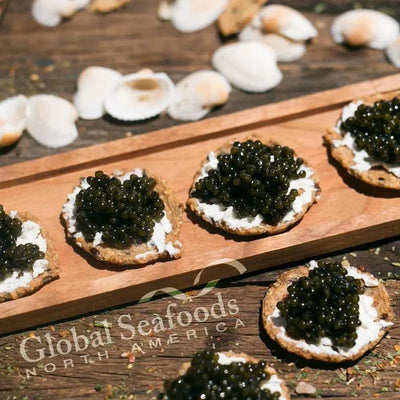How to Choose the Best Black Caviar: A Gourmet’s Ultimate Guide

The Best Black Caviar
Black caviar is a symbol of luxury, elegance, and gourmet indulgence. Sought after by chefs and connoisseurs alike, this delicacy offers a rich, briny flavor and delicate texture that transforms any dish into a culinary masterpiece. However, choosing the best black caviar can be a challenge, especially with so many varieties available, each offering unique taste profiles and textures.
In this guide, we will explore how to select the finest black caviar by looking at the top varieties, key quality markers, and tips on where to buy authentic, premium caviar. Whether you're a seasoned caviar enthusiast or trying it for the first time, this article will provide you with the knowledge you need to enjoy the very best that caviar has to offer.
For more tips and caviar-related content, visit the Global Seafoods YouTube channel, where you’ll find expert advice on how to enjoy this luxury delicacy.
Understanding Black Caviar: What You Need to Know
Black caviar refers to the roe, or eggs, harvested from sturgeon, a family of fish native to the Caspian and Black Seas, though they are now farmed worldwide. The most renowned varieties of black caviar—Beluga, Ossetra, Kaluga, and Sevruga—are known for their delicate flavor and rich, smooth texture. Each type comes from a different species of sturgeon, offering varying levels of saltiness, nuttiness, and creaminess.
Caviar Characteristics to Consider:
- Color: Typically dark gray to jet black, though some varieties may have golden hues.
- Size: Larger pearls are often considered more luxurious, such as those found in Beluga caviar.
- Flavor: Depending on the type of caviar, you may encounter flavors that are briny, buttery, nutty, or earthy.
- Texture: Good caviar should have a firm texture, with each pearl "popping" gently in your mouth.
Types of Black Caviar: Which One Is Right for You?
Choosing the best black caviar begins with knowing the different types available. Each offers a distinct flavor profile, texture, and price range. Here's a closer look at the top varieties of black caviar.
1. Beluga Caviar – The Ultimate Luxury
Beluga Caviar is often considered the finest and most luxurious type of black caviar. Harvested from the Beluga sturgeon, which can take up to 20 years to mature, this caviar is known for its large, soft pearls and delicate, buttery flavor. It is the most expensive and sought-after variety, often reserved for special occasions.
- Flavor: Mild, creamy, and delicate with a subtle brininess.
- Texture: Soft and smooth, with large pearls that gently pop.
- Color: Light to dark gray.
- Best For: Those seeking the ultimate gourmet experience.
Famed chef Thomas Keller once described Beluga caviar as “an unmatched balance of flavor and texture—pure decadence on a spoon.”
2. Kaluga Caviar – A Sustainable Alternative to Beluga
Kaluga Caviar is a close alternative to Beluga caviar and offers a similar luxurious experience. Harvested from the Kaluga sturgeon, also known as "river Beluga," this caviar has large, firm pearls with a rich, buttery flavor and an earthy finish. It is sustainably farmed and often chosen as a more environmentally friendly option compared to wild Beluga.
- Flavor: Rich, buttery, with earthy undertones.
- Texture: Firm pearls with a satisfying pop.
- Color: Dark gray to black.
- Best For: Those seeking a Beluga-like experience with sustainability in mind.
3. Ossetra Caviar – Rich and Nutty
Ossetra Caviar comes from the Ossetra sturgeon, one of the most prized caviar varieties. Known for its medium-sized pearls and firmer texture, Ossetra caviar has a complex flavor that is both nutty and briny, making it a favorite among caviar connoisseurs. It’s slightly less expensive than Beluga but still considered a top-tier option.
- Flavor: Nutty, briny, with a rich complexity.
- Texture: Firm pearls that burst with flavor.
- Color: Varies from dark gray to golden brown.
- Best For: Those who appreciate a balance of brininess and nuttiness.
4. Sevruga Caviar – Bold and Briny
Sevruga Caviar is harvested from the smaller Sevruga sturgeon and is known for its bold, briny flavor. Its pearls are smaller than those of Beluga or Ossetra, but it offers a more intense taste, making it a great choice for those who enjoy a punchier, saltier flavor. Sevruga is also one of the more affordable premium caviar options.
- Flavor: Bold, salty, with a strong briny finish.
- Texture: Small, firm pearls.
- Color: Dark gray to black.
- Best For: Those who enjoy a more robust, savory flavor.
5. Paddlefish Caviar – A Budget-Friendly Choice
Paddlefish Caviar, often referred to as "American caviar," is a more affordable alternative to traditional sturgeon caviar. While it comes from a different species, paddlefish caviar offers a similar briny, earthy flavor with smaller, darker pearls. It’s perfect for those who want to enjoy the taste of caviar without the higher price tag.
- Flavor: Earthy, briny, and robust.
- Texture: Small, firm pearls.
- Color: Dark gray to black.
- Best For: Budget-conscious caviar lovers or those new to caviar.
What to Look for When Choosing the Best Black Caviar
Selecting high-quality caviar goes beyond choosing the right variety. Here are some key factors to consider when determining whether you're getting the best product.
1. Freshness
Freshness is crucial when it comes to black caviar. Look for caviar that smells clean and slightly briny, like the ocean. Any fishy or off-putting odors are a sign that the caviar is not fresh. Always check the expiration date and ensure that the caviar has been stored at the proper temperature (28°F to 32°F).
2. Texture
Good caviar should be firm to the touch. Each pearl should be intact and hold its shape, with a smooth texture that bursts slightly when pressed on the tongue. Caviar that is mushy, broken, or too soft may indicate poor quality or improper storage.
3. Flavor Balance
High-quality black caviar strikes a perfect balance between saltiness and the natural flavor of the roe. It should never taste overwhelmingly salty or fishy. Instead, it should have a smooth, buttery, or nutty flavor with just the right amount of briny undertone.
4. Sourcing and Sustainability
Look for caviar that is ethically sourced and sustainably farmed. Overfishing has led to the depletion of wild sturgeon populations, making sustainable caviar farming crucial. Brands that prioritize sustainability often provide traceable information about where and how their caviar is produced. Global Seafoods offers sustainably sourced options like California White Sturgeon Caviar and Kaluga Caviar, ensuring both quality and environmental responsibility.
Where to Buy the Best Black Caviar
Buying from a trusted supplier is key to ensuring you receive high-quality black caviar. Look for retailers who specialize in luxury seafood and offer detailed information about their sourcing, storage, and shipping processes.
Global Seafoods is a reputable source for premium black caviar, offering a wide range of products including Beluga Caviar, Ossetra Sturgeon Caviar, and Wild Sturgeon Black Caviar. Their commitment to sustainability and quality makes them a top choice for caviar enthusiasts.
Frequently Asked Questions (FAQs) About Choosing Black Caviar
Q1: What’s the difference between farmed and wild caviar?
A: Farmed caviar is produced in controlled environments, allowing for sustainable practices that protect wild sturgeon populations. Modern farmed caviar, such as Kaluga Caviar, is often indistinguishable from wild caviar in terms of quality, flavor, and texture.
Q2: How much caviar should I serve per person?
A: For a caviar tasting or appetizer, plan on serving 1 ounce of caviar per person. If caviar is the main dish, 2 to 3 ounces per person is ideal.
Q3: Can I freeze black caviar?
A: Freezing caviar is not recommended, as it can damage the delicate texture of the pearls. Caviar should be stored in the refrigerator and consumed within a few days after opening.
Q4: How do I know if my caviar is fresh?
A: Fresh caviar should smell like the ocean—clean and briny. If it has a fishy or sour odor, it’s a sign that the caviar is no longer fresh.
Q5: How should black caviar be served?
A: Black caviar is best served chilled, typically on a bed of crushed ice. It should be eaten with a non-metallic spoon (mother of pearl is traditional) to avoid affecting the flavor. Pair it with blinis, crème fraîche, or enjoy it on its own with Champagne or vodka.
Conclusion: Elevate Your Culinary Experience with the Best Black Caviar
Choosing the best black caviar requires knowledge of its varieties, sourcing, and key quality indicators. Whether you’re indulging in the creamy luxury of Beluga Caviar or the bold flavors of Sevruga Caviar, selecting the right caviar ensures a gourmet experience like no other.
For premium black caviar that guarantees both quality and sustainability, explore the wide selection available at Global Seafoods. And for more tips and recipes, check out the Global Seafoods YouTube channel.
Also in News

How to Make Sea Bream Sushi With Dry-Aged Tuna & Crab Roll — Step-by-Step With Chef Joshua
A complete guide to making Sea Bream sushi at home, including filleting, curing, slicing, and building a Dry-Aged Tuna & Crab sushi roll. Chef Joshua shares professional tips for restaurant-quality results.

Boiled Crab for Game Night: Everything You Need for a Perfect Seafood Party
Take your game night to the next level with a Boiled crab party. Learn the best recipes, cooking tips, and hosting hacks for a memorable seafood feast.

Boiled Crab for Date Night: A Romantic Guide to the Perfect Seafood Feast
Make your next date night unforgettable with a romantic Boiled crab experience. This guide covers everything you need to know, from ambiance to the best crab varieties.

